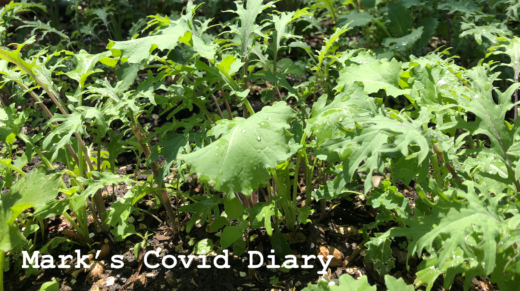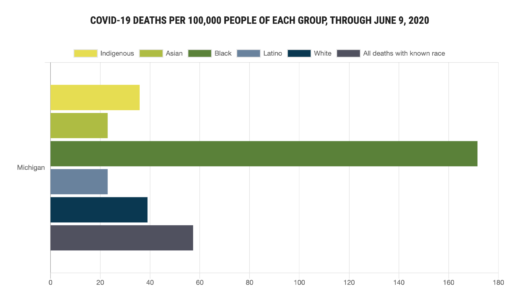
Since we last spoke, the bodies of two black men have been found hanging from trees in California, an armed militia member shot a protester in Albuquerque who was trying to pull down the statue of a 16th-century Spanish conquistador, and three police officers in New York City have claimed to have been served bleach milkshakes by fast-food workers. The last story, as you may have heard, turned out not to have been true. Sadly, however, the other two are. Oh, and, Texas, Florida and Arizona all experienced their biggest COVID-19 infection spikes to-date today. Closer to home, we now have 6,034 COVID-19 deaths here in Michigan. And yet, from what I can tell, we pretty much continue to slog forward as though nothing’s wrong.
I had to go to Kroger today, as we needed something. It was my first time since the shutdown, some 100-days ago. And the number of people not wearing masks was way more than I’d expected… Kroger used to be my main go-to grocery store. When the shutdown hit, though — after a period of having our groceries delivered — I started going to Costco, as they require for everyone inside their stores to wear masks. It seemed to me like a good, responsible policy, and I wanted to support their decision, especially knowing that the anti-science, “I demand my right to put myself and others in danger”-shouting Trump supporters among us would be attacking them for taking the public health-informed stance. And Kroger, which is considerably closer to my home, never even attempted to do the right thing.
Fortunately, I have the $60 to pay for the annual Costco membership, and the ability to afford the upfront cost of buying things in bulk. And I have a car, which allows me to drive to Costco, and buy quantities of things that I couldn’t possibly hope to get home by bus. And, as a result, I get to shop more safely. It hardly seems fair, but there it is. And, of course, there’s even that level above, of people who pay other people to go to stores like Kroger for them, and contend with the maskless hordes on their behalf. And, at the outset of this, as I noted earlier, we did that as well. We literally didn’t leave home for the first few months, as we waited to see whether or not our local hospitals would be pushed beyond capacity. Others, of course, did not have that luxury. Unlike me, they couldn’t work from home, had to continue taking public transportation, etc… all of which put them and their loved ones at great risk. [The opportunities for “privilege self-examination” are everywhere these days.]
As for my experience at Kroger today, I was talking with a PhD friend about it, noting all of the people without masks, when I shared the completely unscientific observation that most of the people not taking precautions were white. And this led to a conversation about the fact that most white people likely still don’t personally know anyone who has died from COVID-19, during which my friend offered the following observation. “Things will likely change when we reach 300,000 deaths,” she said. “At that point, pretty much everyone in the United States will know someone who has died.” I don’t know how she arrived at that number, but, assuming she’s right, it’s a terrifyingly large number to contemplate. And, if true, it makes one wonder what’s wrong with us as a nation that we won’t take action until we actually see the death in our own lives. [By the same token, maybe we’ll get gun reform once we all have a neighbor who has lost a child in a school shooting.]
From my own experience, I can certainly say that I see a difference between how I see the pandemic, as someone who has lost a friend, and how some others see it. Without getting too far into it, I’d like to share one anecdote which I think encapsulates this moment of ours pretty well. I was on a video call a little while ago with the husband of my friend in Detroit who passed during the first big wave. It was heartbreaking, as you can imagine. And we were at a point in our conversation where we were talking about his recovery. [He not only had to deal with the loss of his wife, but to do so while also suffering with the disease himself.] So, as we were talking about his chronic lung issues as a result of COVID-19, and how much we still don’t know about the long-term effects of the disease, I had a notice on my screen pop up from a relative who, after telling me she ready to get her “life back,” informed me that she was taking a short vacation, and wanted for me and the family to join her. It was jarring, just sitting there, at my desk, straddling these two realities. And I do think, to a large extent, it comes down to how wide your circle of friends is, and what your own experience has been with the disease. To a lot of people, I’m afraid, it’s just an abstract kind of thing… something that doesn’t even seem real. It’s like staring into the ocean after watching Jaws for the first time. You’re scared, but it’s not like you’ve ever even heard of anyone getting anywhere near a shark, let alone being eaten by one. So, after a little while, you decide to venture in. It doesn’t make you bad. It’s not like you’re yelling, “hoax.” It’s just not part of your reality. Meanwhile, though, if you know nurses treating these people, and you know people who have died from it, or who have fought it off and are still struggling, you know exactly how fucking real it is.
Interestingly, after talking with my PhD friend today, and noting how black folks here in Ypsilanti seemed to be taking the threat more seriously than white folks, as least based on mask usage, I saw an Associated Press article co-authored by our old friend Katrease “Kat” Stafford, formerly of the Ann Arbor News, and now on to much bigger and better things with national bylines. [Congratulations, again, Katrease.] Here’s the article’s headline: “Black Americans most likely to know a COVID-19 victim, polls find.” And here’s a brief excerpt from the article.
…Eleven percent of African Americans say they were close with someone who has died from the coronavirus, compared with 5% of Americans overall and 4% of white Americans.
The findings are based on data from three COVID Impact surveys conducted between April and June by NORC at the University of Chicago for the Data Foundation about the pandemic’s effect on the physical, mental and social health of Americans…
It’s not surprising, of course, given the legacy of racism we’re still living with in America, and the various health factors which continue to put African Americans as greater risk, but, when you see the COVID-19 fatality numbers broken down by race, it’s sobering. Looking at American society through the lens of COVID really puts things in perspective. It makes it clear where both the privilege and inequalities reside.

In Michigan, four times as many black people have died as white people as a result of this pandemic, and that’s with just 14% of Michigan’s population being African American. That’s absolutely indefensible. [Across the nation, 2.3 times as many black Americans are dying from COVID-19 as white Americans.]
While we’re on the subject, I just saw the following from University of Michigan professor Enrique Neblett about how the impacts of COVID-19 may be generational in the black community.
Black Americans are disproportionately likely to say a family member or close friend has died of #COVID19 since March, according to new surveys.@umichsph's @DrNeblett spoke w/ @NewsHour about the impacts of that loss, economic fallout, and unrest: https://t.co/3jp4SaV1b0
pic.twitter.com/N9PyFtPh5d
— MichiganPublicHealth (@umichsph) June 16, 2020
When I’d set out to write tonight, my thought was to write about my kale crop, which is coming in incredibly well. [We just ate from the garden for the first time this evening, and it was great.] It hardly seems appropriate now — seeing as how I’ve decided to focus instead on more weighty and important subject matter — but I figure that I should at least mention it, seeing as how I started the post with a photo of my kale.
OK, as I still have a few minutes before my self-imposed curfew. Here’s the transcript from a tweet thread shared by CNN’s Marshall Cohen earlier this evening… just in case, after reading the above, you thought that things couldn’t possibly get any worse. [The links are mine.]
A member of the far-fight “Boogaloo” movement allegedly killed two cops during Oakland’s post-Floyd riots. Three Boogaloo members allegedly infiltrated BLM protests in Las Vegas and tried to blow up a power station, according to the DOJ. Trump hasn’t said a word about this. Meanwhile, Trump has his own version of reality. He claimed Antifa and far-left groups were responsible for 100% of the violence and told Americans not to “lay the blame on others.” He also claimed, unprompted, that white supremacists weren’t “mixing in” with the rioters. The DOJ still hasn’t charged any Antifa members, though Barr says there are several investigations underway. Surely, left-wing extremists are responsible for some, perhaps most, of the post-Floyd violence. But Trump exaggerates their role and fully ignores far-right groups.
So, for those of you keeping track, we now have very real evidence that far-right provocateurs were active in the protests surrounding the murder of George Floyd, attempting to use them as a way of advancing their own nefarious objectives. At the same time, and in spite of everything we’ve heard to-date from Donald Trump, we have no evidence of coordinated ANTIFA activity aimed at increasing violence, chaos, etc. Do with that knowledge what you will.

There’s more that I want to say, but the alarm is ringing, and I intend to honor it. Until tomorrow, my friends.




















